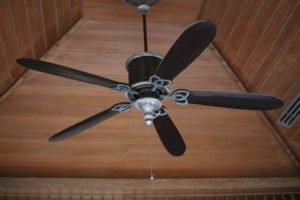
During the winter, run your fan at low speed in a clockwise direction. (Pixabay)
Amid the hustle and bustle of life, most of us don’t think much about saving money on energy. But when the utility bills finally arrive, we often wonder what we could have done to cut back. This winter, save energy by following a few simple tips.
Open Curtains on South-Facing Windows
Curtains can serve multiple purposes. In the summer, energy-efficient curtains can prevent heat from invading your home. In the winter, they can help retain heat. You can control how much sun is allowed to enter your home by simply opening or closing the curtains. During the cooler months, open the curtains during the day to allow natural sunlight to flood your home and lessen the burden on your furnace. South-facing windows provide the best natural light. As the sun sets, close the curtains to prevent heat from escaping.
Use LED Holiday Lights Instead of Incandescent Lights
With the holidays right around the corner, it’s now time to think about how you can save on your light bill. Switching to LED lights means a higher upfront cost but lower energy bills indefinitely. According to the Department of Energy, LEDs consume 80 percent less energy than traditional incandescent lights and last about 25 times longer.
Buy a Space Heater for Rooms Where You Spend the Most Time
There’s no point in heating the entire house if you spend most of your time in one or two rooms. Turn down the main heat and use portable space heaters in the rooms where you spend the majority of your time. If you’re considering purchasing a space heater, be sure to look closely at the features. Buy one designed to heat a space the size of the room you are planning to use it in. Also compare wattages of models to see which use less energy. You may also want a space heater with thermostat and timer settings to prevent the room from overheating and save energy.
Lower the Temperature of Your Water Heater
Lowering the temperature on your water heater is a simple way to save energy. Setting your water heater between 115 and 120 degrees Fahrenheit should be adequate for most household needs. You may also want to consider upgrading to a tankless water heater to save even more. While traditional water heaters maintain a full tank of warmed water, tankless water heaters only heat water on demand.
Reverse the Fan Blades on Your Home’s Ceiling Fans
Ceiling fans can be used to keep rooms cool in the summer and warm in the winter and save energy year-round. During the summer months, set the blades to turn in a counter-clockwise direction. This produces a breeze that makes you feel cooler. In the winter, reverse the fan motor to run in a clockwise direction. As warm air rises, the fan forces the air near the ceiling to return back into the occupied space.
Close Off Rooms You Don’t Need to Heat
Sealing off unused rooms in your home is an easy way to keep energy costs down. If you have forced-air heating, simply close the vent and the door to the room. You may also choose to seal the area around the door to prevent cold drafts from entering the occupied areas of the home.
